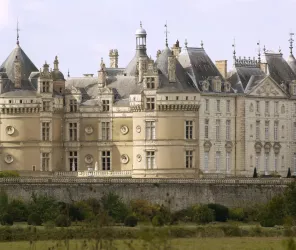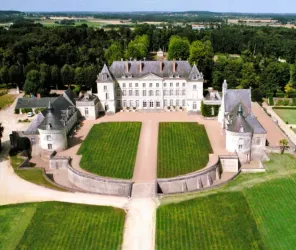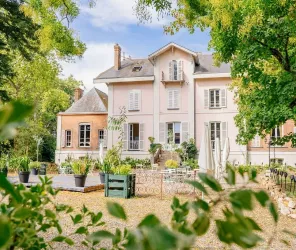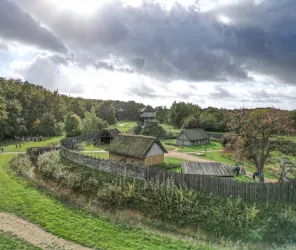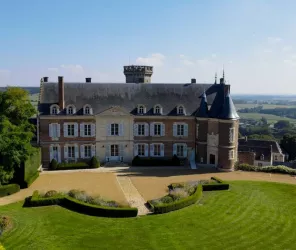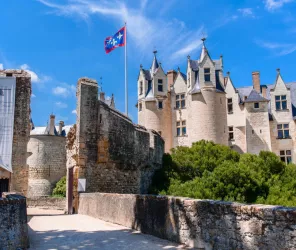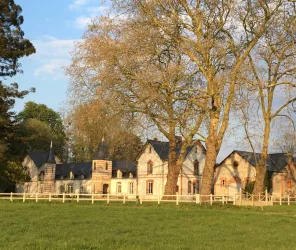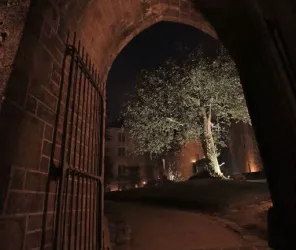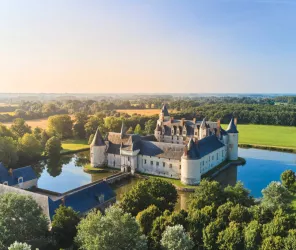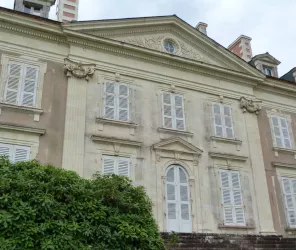
Le château et la chapelle de Grandville
A fine early 19th century residence, the columns of the balcony are reminiscent of the Italian style. It was built by Aristide de Grandville, mayor of Port-Saint-Père for twenty-two years.
Domaine de la TourA native of Saint-Malo, Charles-Jean Locquet de Grandville (1716-1792), knight, marquis of Fougeray, secretary to the King at the Chancellery of Brittany, was quickly ennobled by the rulings of 1700 and 1707.
In 1786, the aristocrat acquired the land of La Tour in Port-Saint-Père, which he bequeathed to his son Félix-Victor on his death. In reality, this estate served as an annuity for the Locquet family.
During the events of 1789, Félix-Victor Locquet, Marquis de Fougeray (1760-1793), became involved in the schemes of the Breton colonel Armand de La Rouërie.
He also had to look after his two sons, Achille and Aristide, after the death of his wife, Victoire Gouyon de Beaufort, in 1792. Accused of plotting, he was sentenced to death on 18 June 1793 in Paris.
His minor sons became the sole heirs to the Tour estate and its outbuildings.
Achille Locquet de Grandville (1789 -), nicknamed the Marquis de Grandville, became lord of La Rivière in Port-Saint-Père.
His brother Aristide lived at Château de la Tour until it was sold in 1820. He also built the château de Grandville and its chapel.
The development of Port-Saint-Père
Aristide de Grandville (1791-1853) became involved in local life, becoming mayor of Port-Saint-Père in 1818. He served as mayor from 1818 to 1830, then from 1838 to 1848. A general councillor, he was also elected as a deputy to the Constituent Assembly in 1848.
He was the initiator of major projects such as :
the stone bridge
the extension of the church
the regulation of water levels in Lake Grandlieu,
the arrival of the railway,
but also the introduction of regulations banning gambling in the commune.
Grandville Castle
Heir to Château de la Tour, Aristide sold it with the agreement of his elder brother. Between 1820 and 1825, he had the Château de Grandville built on the hillside opposite it. The building was based on plans by the architect Étienne Blon (1780-1863), who designed the Place Mellinet in Nantes.
The building features a portico with columns. It is one of the rare examples of neo-Palladian architecture in the Nantes region, inspired by 16th-century Italian villas.
The château is a large square residence with a ground floor and two upper floors. It is large without being immense.
Following the construction of his château, Aristide had the English-style park designed around 1845, based on studies he commissioned from two famous landscape gardeners:
André Leroy (1801-1875), a great nurseryman and arboriculturist from Anjou, whose project never materialised.
Jean-Dominique Noisette, a landscape gardener and the eldest son of Antoine Noisette (1778-1858), head gardener at the Jardin des Plantes in Nantes. He was responsible for some of Nantes' finest landscaping projects, including the Parc de la Chantrerie and the Parc de Procé. It was his design, completed in 1851, that was used to shape the park.
In 1844, the neo-Gothic chapel was built a few metres from the house. It was designed by Nantes-based diocesan architect Théodore Nau (1805-1865).
Dedicated to Sainte Anne, it was inaugurated by the Bishop of Nantes, Monseigneur de Hercé.
Anecdote
The Château de Grandville was very lively at the time. In particular, Aristide was in the habit of welcoming some fine people. Such was the case with Jean-Anne Dubois-Violette, a shipowner and merchant from Nantes, who owned Château de Briord when he sold his property. Gambling evenings were commonplace. On one wild night, Aristide gambled away his château and lost it to Dubois-Violette. The latter, a great lord, left the house to his neighbour and settled for a house in La Lucerie, a hamlet between Grandville and Briord.
Aristide de Grandville died in 1853 in Port-Saint-Père.
Since then, his descendants have succeeded him at Grandville.
When Aristide de Grandville died, the estate passed to his son-in-law, Stéphane de Moulin de Rochefort. The estate then passed to the Dampierre family through marriage. Then, again by marriage, it devolved to the d'Argenlieu family, for 3 generations, who have been restoring it for several years.
The château was listed as a historic monument in 1992.
Bonus: the site is privately owned, but you can visit the outside of Château de Grandville (€2), including the gardens and chapel, during the summer months, from 14 July to 22 August (10am-12pm / 2pm-6pm) and during the European Heritage Days in September (with a signposted route through the grounds and a guided tour of the chapel).
Did you know? The spire of Saint-Pierre church in Port-Saint-Père was financed in part by a bequest from Aristide de Grandville's widow, Sophie Martel (1799-1881).
Contact
Grandville
44710 PORT-SAINT-PERE
FRANCE
44710 PORT-SAINT-PERE
FRANCE
Practical information
Site theme
Chapel
Castle
Architectural style of the site
19th century



